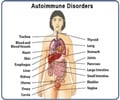Rasmussen's encephalitis has recently been proved to be an autoimmune disorder by researchers who worked on humanized mice to study the disease.
- The current study reveals that chronic focal encephalitis or Rasmussen's encephalitis has autoimmune origins.
- Rasmussen's encephalitis is a rare neurological disorder that mostly occurs in children below than ten years old.
- The disease usually affects one hemisphere of the brain and causes recurring epileptic seizures.
Also, treatments proposed to slow down disease progression in affected children have produced contradictory results, particularly in the long term.
Lionel Carmant and Elie Haddad are professors in the Department of Pediatrics at UdeM and researchers at CHU Sainte-Justine, and together they came up with the idea to use these valuable humanized mice to study chronic focal encephalitis.
Study – using humanized mice to study rare diseases
- Humanized mice lack an immune system, and hence are used to study the human immune system and in particular illnesses such as cancer, leukemia, HIV and sometimes specific allergies and inflammatory diseases.
- In the current study the scientists introduced immune cells from patients with Rasmussen's encephalitis into the mice; since the mice do not have an immune system, they are unable to reject the cells
- The researchers then observed the mice and noticed that they developed violent convulsions and brain necrosis, just like their human counterparts
- When they took biopsies of the mice's brains, they noticed the immunological damage of the rodent brains was practically identical to that in human
- By this, they proved the disease has immune origins
Advantages of using humanized mice to study Rasmussen's encephalitis
Experiments done on humanized mice -- Allow for a more precise diagnosis - this is of great help mainly because there are no biological markers for Rasmussen's encephalitis which mean it is difficult to diagnose the disease in certain children.
- Has the possibility of making early diagnoses which will help patients get proper treatment early on - it might then be possible to avoid disease consequences like the cognitive decline and possible brain surgery (hemispherectomy).
- Can help test various treatments and determine the best one for each sick child - this can pave the way to 'personalized' or 'precision' medicine."
Rasmussen's encephalitis
Chronic focal encephalitis, or Rasmussen's encephalitis, was discovered by a neurosurgeon, Théodore Rasmussen who specialized in treating epilepsy. It is a rare (up to two cases of Rasmussen's encephalitis are diagnosed each year in Canada) and devastating inflammatory brain disease that most often develops in children. It is a degenerative affliction with causes unknown and characterized by recurring epileptic seizures that resist conventional antiepileptic treatments.In more serious cases, the number of seizures can only be reduced by either disconnecting the two hemispheres of the brain or removing one of them and dealing with the neurological consequences. As the disease progresses, it triggers cognitive decline and severe learning disabilities.
References:
- Humanized mouse model of Rasmussen’s encephalitis supports the immune-mediated hypothesis - (https://www.jci.org/articles/view/97098)
- Hania Kebir, Lionel Carmant et al., "Humanized mouse model of Rasmussen's encephalitis supports the immune-mediated hypothesis", Journal of Clinical Investigation, April 9, (2018). https://doi.org/10.1172/JCI97098
Source-Medindia
















